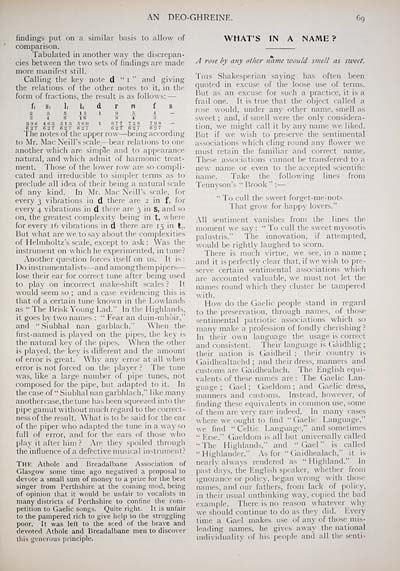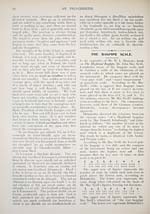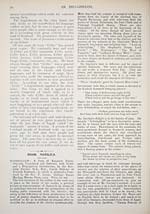Blair Collection > Deo-gréine
(89)
Download files
Complete book:
Individual page:
Thumbnail gallery: Grid view | List view

AN DEO-GHREINE.
69
findings put on a similar basis to allow of
comparison.
Tabulated in another way the discrepan-
cies between the two sets of findings are made
more manifest still.
Calling the key note d " 1 " and giving
the relations of the other notes to it, in the
form of fractions, the result is as follows: —
fi Si li ti d r pi f s
F2T 6"2T 627 8 2T 62T 6 2T 6IT
The notes of the upper row — being according
to Mr. Mac Neill's scale; — bear relations to one
another which are simple and to appearance
natural, and which admit of harmonic treat-
ment. Those of the lower row are so compli-
cated and irreducible to simpler terms as to
preclude all idea of their being a natural scale
of any kind. In Mr. Mac Neill's scale, for
every 3 vibrations in d there are 2 in f, for
every 4 vibrations in d there are 3 in S, and so
on, the greatest complexity being in t, where
for every 16 vibrations in d there are 15 in t,.
But what are we to say about the complexities
of Helmholtz's scale, except to ask : Was the
instrument on which he experimented, in tune?
Another question forces itself on us. It is :
Do instrumentalists — and among them pipers —
lose their ear for correct tune after being used
to play on incorrect make-shift scales ? It
would seem so ; and a case evidencing this is
that of a certain time known in the Lowlands
as " The Brisk Young Lad." In the Highlands,
it goes by two names : " Fear an duin-mhòir,"
and "Siubhal nan garblach." When the
first-named is played on the pipes, the key is
the natural key of the pipes. When the other
is played, the key is different and the amount
of error is great. Why any error at all when
error is not forced on the player ? The tune
was, like a large number of pipe tunes, not
composed for the pipe, but adapted to it. In
the case of " Siubhal nan garbhlach," like many
another case, the tune has been squeezed into the
pipe gamut without much regard to the correct-
ness of the result. What is to be said for the ear
of the piper who adapted the tune in a way so
full of error, and for the ears of those who
play it after him ? Are they spoiled through
the influence of a defective musical instrument?
WHAT'S IN A NAME ?
The Athole and Breadalbane Association of
Glasgow some time ago negatived a proposal to
devote a small sum of money to a prize for the best
singer from Perthshire at the coming mod, being
of opinion that it would be unfair to vocalists in
many districts of Perthshire to confine the com-
petition to Gaelic songs. Quite right. It is unfair
to the pampered rich to give help to the struggling
poor. It was left to the seed of the brave and
devoted Athole and Breadalbane men to discover
this generous principle.
A rose by any other name -would smell as sweet.
This Shakesperian saying has often been
quoted in excuse of the loose use of terms.
But as an excuse for such a practice, it is a
frail one. It is true that the object called a
rose would, under any other name, smell as
sweet ; and, if smell were the only considera-
tion, we might call it by any name we liked.
But if we wish to preserve the sentimental
associations which cling round any flower Ave
must retain the familiar and correct name.
These associations cannot be transferred to ;i
new name or even to the accepted scientific
name. Take the following lines from
Tennyson's " Brook " : —
"To cull the sweet forget-me-nots
That grow for happy lovers."
All sentiment vanishes from the lines the
moment we say : " To cull the sweet myosotis
palustris." The innovation, if attempted,
would be rightly laughed to scorn.
There is much virtue, we see, in a name ;
and it is perfectly clear that, if we wish to pre-
serve certain sentimental associations which
are accounted valuable, we must not let the
names round which they cluster be tampered
with.
How do the Gaelic people stand in regard
to the preservation, through names, of those
sentimental patriotic associations which so
many make a profession of fondly cherishing ?
In their own language the usage is correct
and consistent. Their language is Gàidhlig ;
their nation is Gaidheil ; their country is
Gaidhealtachd ; and their dress, manners and
customs are Gaidhealach. The English equi-
valents of these names are : The Gaelic Lan-
guage ; Gael; Gaeldom ; and Gaelic dress,
manners and customs. Instead, however, of
finding these equivalents in common use, some
of them are very rare indeed. In many cases
where we ought to find "Gaelic Language,"
we find " Celtic Language," and sometimes
" Erse." Gaeldom is all but universally called
"The Highlands," and "Gael" is called
" Highlander." As for " Gaidhealach," it is
nearly always rendered as " Highland." In
past days, the English speaker, whether from
ignorance or policy, began wrong with those
names, and our fathers, from lack of policy,
in their usual unthinking way, copied the bad
example. There is no reason whatever why
we should continue to do as they did. Every
time a Gael makes use of any of those mis-
leading names, he gives away the national
individuality of his people and all the senti-
69
findings put on a similar basis to allow of
comparison.
Tabulated in another way the discrepan-
cies between the two sets of findings are made
more manifest still.
Calling the key note d " 1 " and giving
the relations of the other notes to it, in the
form of fractions, the result is as follows: —
fi Si li ti d r pi f s
F2T 6"2T 627 8 2T 62T 6 2T 6IT
The notes of the upper row — being according
to Mr. Mac Neill's scale; — bear relations to one
another which are simple and to appearance
natural, and which admit of harmonic treat-
ment. Those of the lower row are so compli-
cated and irreducible to simpler terms as to
preclude all idea of their being a natural scale
of any kind. In Mr. Mac Neill's scale, for
every 3 vibrations in d there are 2 in f, for
every 4 vibrations in d there are 3 in S, and so
on, the greatest complexity being in t, where
for every 16 vibrations in d there are 15 in t,.
But what are we to say about the complexities
of Helmholtz's scale, except to ask : Was the
instrument on which he experimented, in tune?
Another question forces itself on us. It is :
Do instrumentalists — and among them pipers —
lose their ear for correct tune after being used
to play on incorrect make-shift scales ? It
would seem so ; and a case evidencing this is
that of a certain time known in the Lowlands
as " The Brisk Young Lad." In the Highlands,
it goes by two names : " Fear an duin-mhòir,"
and "Siubhal nan garblach." When the
first-named is played on the pipes, the key is
the natural key of the pipes. When the other
is played, the key is different and the amount
of error is great. Why any error at all when
error is not forced on the player ? The tune
was, like a large number of pipe tunes, not
composed for the pipe, but adapted to it. In
the case of " Siubhal nan garbhlach," like many
another case, the tune has been squeezed into the
pipe gamut without much regard to the correct-
ness of the result. What is to be said for the ear
of the piper who adapted the tune in a way so
full of error, and for the ears of those who
play it after him ? Are they spoiled through
the influence of a defective musical instrument?
WHAT'S IN A NAME ?
The Athole and Breadalbane Association of
Glasgow some time ago negatived a proposal to
devote a small sum of money to a prize for the best
singer from Perthshire at the coming mod, being
of opinion that it would be unfair to vocalists in
many districts of Perthshire to confine the com-
petition to Gaelic songs. Quite right. It is unfair
to the pampered rich to give help to the struggling
poor. It was left to the seed of the brave and
devoted Athole and Breadalbane men to discover
this generous principle.
A rose by any other name -would smell as sweet.
This Shakesperian saying has often been
quoted in excuse of the loose use of terms.
But as an excuse for such a practice, it is a
frail one. It is true that the object called a
rose would, under any other name, smell as
sweet ; and, if smell were the only considera-
tion, we might call it by any name we liked.
But if we wish to preserve the sentimental
associations which cling round any flower Ave
must retain the familiar and correct name.
These associations cannot be transferred to ;i
new name or even to the accepted scientific
name. Take the following lines from
Tennyson's " Brook " : —
"To cull the sweet forget-me-nots
That grow for happy lovers."
All sentiment vanishes from the lines the
moment we say : " To cull the sweet myosotis
palustris." The innovation, if attempted,
would be rightly laughed to scorn.
There is much virtue, we see, in a name ;
and it is perfectly clear that, if we wish to pre-
serve certain sentimental associations which
are accounted valuable, we must not let the
names round which they cluster be tampered
with.
How do the Gaelic people stand in regard
to the preservation, through names, of those
sentimental patriotic associations which so
many make a profession of fondly cherishing ?
In their own language the usage is correct
and consistent. Their language is Gàidhlig ;
their nation is Gaidheil ; their country is
Gaidhealtachd ; and their dress, manners and
customs are Gaidhealach. The English equi-
valents of these names are : The Gaelic Lan-
guage ; Gael; Gaeldom ; and Gaelic dress,
manners and customs. Instead, however, of
finding these equivalents in common use, some
of them are very rare indeed. In many cases
where we ought to find "Gaelic Language,"
we find " Celtic Language," and sometimes
" Erse." Gaeldom is all but universally called
"The Highlands," and "Gael" is called
" Highlander." As for " Gaidhealach," it is
nearly always rendered as " Highland." In
past days, the English speaker, whether from
ignorance or policy, began wrong with those
names, and our fathers, from lack of policy,
in their usual unthinking way, copied the bad
example. There is no reason whatever why
we should continue to do as they did. Every
time a Gael makes use of any of those mis-
leading names, he gives away the national
individuality of his people and all the senti-
Set display mode to: Large image | Transcription
Images and transcriptions on this page, including medium image downloads, may be used under the Creative Commons Attribution 4.0 International Licence unless otherwise stated. ![]()
| Early Gaelic Book Collections > Blair Collection > Deo-gréine > (89) |
|---|
| Permanent URL | https://digital.nls.uk/76698672 |
|---|
| Description | A selection of books from a collection of more than 500 titles, mostly on religious and literary topics. Also includes some material dealing with other Celtic languages and societies. Collection created towards the end of the 19th century by Lady Evelyn Stewart Murray. |
|---|
| Description | Selected items from five 'Special and Named Printed Collections'. Includes books in Gaelic and other Celtic languages, works about the Gaels, their languages, literature, culture and history. |
|---|

